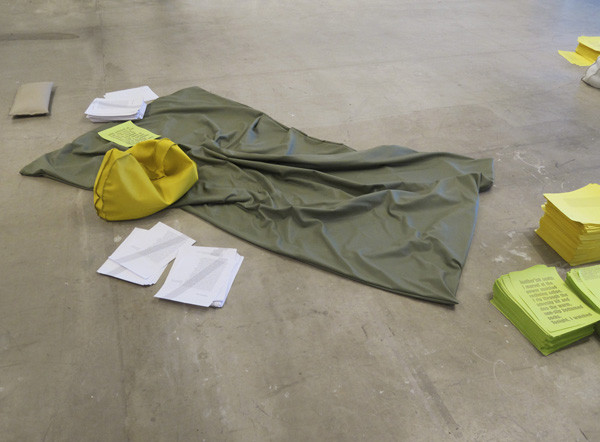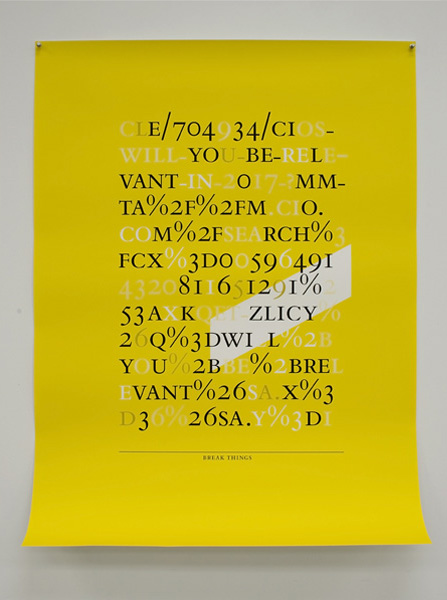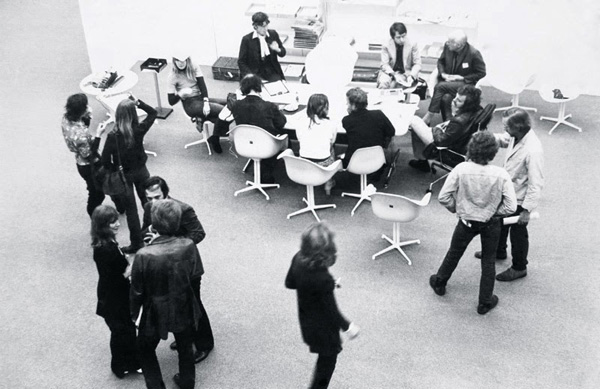Witness Julietta Cheung
What gets in, what gets out

The alternative space Ballroom Projects is located in the Bridgeport neighborhood of Chicago, near where I live. Once a third floor ballroom that would have hosted family banquets in this working class area, it was later colonized by punks who put on hardcore shows. You have to walk up three flights of steep steps to reach its tall, cavernous space, which is surrounded on three sides by a mezzanine built out with bedrooms. Lovely banks of tall windows face south. It’s on Archer Street, backed up against Interstate 55, which one never ceases to hear through the cold, brown brick walls. It’s now informally linked to the School of the Art Institute of Chicago; students and graduates of SAIC, where I teach, run it as a live-in project space. Robert Fitterman read there this spring, with Josef Kaplan, Holly Melgard, and Joey Yearous-Algozin. I read there one night in 2012. But it wasn’t a poetry reading. I was at one of many fascinating exhibits the space has hosted over recent years. And I was reading silently to myself, page by page from a stack of 8 ½ x 11 sheets set on the floor, one stack among several, something about or repeatedly extolling “true exposure.” The piece is by Julietta Cheung. A few of us entered a central space strewn with these stacks and some custom built cushions, sat down and read, left to the periphery to mingle, and returned. Everything and everyone must have felt under surveillance. Well, I did. To get to the heart of the piece, I had to get over my own preoccupation with reading as a private, silent, and portable activity. Or so I thought, perhaps wrongly. I was still reading in isolation, and projecting that by isolating the phrase “true exposure” as not only the title but the key to the piece.
Cheung’s website introduces the piece this way:
True Exposure invites viewers to question the collective shaping of culture defining terms. In this case, the term is "innovation." First, the search term "innovation" was applied across a variety of on-line news media outlets, blogs and social networking sites. Then the search results were copied. In each set of results, "innovation" was replaced by the equally ambiguous term "true exposure." A possible lexicography around "true exposure" was further applied to replace recurring associations.
By “recurring associations,” I read both clichés and the compiled synonymies of online tractability, i.e. the way terminology is delivered unto itself via “relevance.” Sentimental deliverance, too, à la “Flarf” circa 1998-2004. Because cognates, including the verb “innovate” and the substantive “innovator,” are also substituted by the phrase “true exposure,” her texts share the occasional trait of syntactic disjunction found in a Flarfist poem. The repetition of the phrase and its indeterminate semantic value conspire to solicit reverence. What is this heavenly object, thing, reason, concept, act, or character beaming through all manner of discourse, “true exposure”?
Cheung’s statement continues, forcing an equivocation between the practices of “recent corporate brainstorming sessions and '90s Relational Art.” I love a good dialectic like this. Usually enjoy it more than I trust it. In a talk Cheung delivered at the College Art Association, the artist explains,
Few singular words reflect so well the underlying drive of modernity and modernization as "innovation": and because contemporary uses of the term have collapsed participation as an inherent practice within industry, I decided to use exhibition venues as the key space of participation in art—to contrast our value assumptions about participation in art and everyday consumption. After contemporary art’s social turn, there is the implicit assumption that works involving collaborators or facilitating viewer participation are the antidote to the commercialism of the art world and to hegemony in general. But if we have sought to blur art and the everyday in the past to challenge the status quo, it is also time we reflect on participation as it has become entrenched in both contexts.
I also love being engulfed by a semantic puzzle, especially when the dispassionate spectators surrounding me amplify its exposition. One/it is exposed to view. The closed environment of Ed Ruscha’s Chocolate Room and the infinitely relaxed ambiance of Tan Lin’s reading environment, which I discuss in a previous commentary, are replaced with a theater in the round. Reversal is the implied zenith of “innovation”; a modern Copernican revolution of convenience, now that market research, R&D, and publicity are fully integrated into our leisure routines. The semi-private exhibition space, a party, really, was the ideal setting for my initiation into this odd sort of kiosk. (Even the furniture, so to speak, makes the most of modernist design tropes.)
The phrase “true exposure” is about what gets in and what gets out, influence and emission. Though I would not want to reduce the phrase to a pun, this does have some semantic resonance with the feeling of being on view that I had at the Ballroom, being watched or looked at as I read. Think of how attention is partitioned around reading. In an environment like a library there are commons but also cubbies, claustrophobia is the obverse of faux rapport. Laptop and data phone screens are just between you and it, especially on mass transit or in a public forum, like a cafe or checkout lane. An installation is never something you can stand before, like a painting. It is never entirely visible. Even in a sculpture garden, everything crawling over, landing upon, or blocking view of a piece diverts attention. Sight lines are inherently subjective in an environment like Cheung’s. And another is embedded, the space between reader and sheet of paper, itself designed as data output. The era of the database and the index also inaugurates a certain spectatorial etiquette.
Boundless polysemy rather than ambiguity becomes the norm. The series of glossaries embedded in her texts is a catalyst for it. In photography, what gets through the lens to make “contact” and then “develops” in strict accordance, “true exposure” is exactly ambiguous, a duality, the ambidexterity of the process behind a final product. The center and periphery of the environment suggests another two-part trope. These two denotations can be paired. But others rush into view. Cheung describes its definition in banking as
a method of forecasting debt and calculating insurance and financial risks…it is [also] used to characterize the views of the landscape along hiking trails; and it also describes how real estate properties fair against climate change. The common denominator across all of these contexts is change and visibility—making "true exposure" the perception of change or the ability to see clearly in times of change.
Just as with “innovation,” a circulatory system of semio-capital, quasi-anthropological, and reappropriated counter-cultural relations works like what translators and educators call a “target language.” Cheung again: “the consultant packages the participants’ content, their labor and their production as the billable outcome,” after observing consumers in the wild, i.e. the shopping mall. The proliferation of dualities makes the dueling viewpoints illegible as such: indeterminate rather than paradoxical. Hermeneutic freedom (the right to my opinion) is resold.
I wanted to describe to you the environment in which I first encountered True Exposure. My aim was to evoke the recreational palace of the shopping mall without speaking of anything but an “alternative space.” I wanted the outcome along with its culpability: ambiguity. What Cheung calls the difference between “participation as an activity and participation as a product” could be made to rehearse the debates surrounding “participatory reading” that peaked in the twilight hours of Language Writing, those which, for instance, palpably haunt each and every contribution to The Politics of Poetic Form. But for now, I am interested in having been lured into the focus group, only to find that I was not meant to read a thoroughly aestheticized text, visually composed and even decorated (on high-output colored paper).

A stack is usually uniformly yellow, green, very Kinkos. No clip-art that I recall, but “style sheets” are in play by the compositor, who seems not to have mastered—or maybe wants to foreground—the copy machine, by letting the registration miss. The text will run off the margins, continue onto another sheet, a paragraph split between two. Maybe a page will be mostly an exaggerated space between paragraphs or other sub-sections. There are headings, footers, stripes, and other diacritical or columnar flourishes. There is a nearly caricatured self-consciousness of what Derrida, in The Truth in Painting, called the parergon—the frame between the inside and the outside of a “piece.” The rhetorical value of these cues is clear, and I have been modifying my description of them accordingly. The text is a kind of signage, and is designed as such. But as a reading experience, in the proper, feigned solitude of my predicament, I find myself enlisted to hold forth. I shudder as I realize the theatricality of being so emplaced. Everything I could pronounce would be vapid. So I mutely meander instead.
I do like to read over shoulders. I don’t read phones, don’t own one. On the train, I read books. I rest easy I’m the only one paying attention to the page, hearing that silent voice internally. The density of the prose and esotericism of the verse in my books will repulse the casual voyeur, I guess. It could intrigue them, instead. But when I’m made to stand, I watch a seated passenger play a game or scroll through status updates. I don’t want to care. It is enormously relaxing and intimate.

Artist Placement Group's "The Sculpture," installation view of Inno70 (1971), Hayward Gallery, London
This form of voyeurism is really classical irony metastasized to the theater of reading spaces that have been such a telling feature of “social practice” exhibits. I think of Claire Bishop’s discussion, in Artificial Hells, of Artist Placement Group’s actually innovative “Inno70” show. A piece entitled “The Sculpture” was in fact a working boardroom where curator, artists, and corporate representatives met to arrange collaborative “placements” of artists within their organizations. These were contractual negotiations, replete with verbal documentation in various states of revision, reference materials including civil codebooks, etc. But for the fact that “the public…were separated from the boardroom by a clear plastic curtain.” At the ballroom, it was more a matter of lighting (and in the gallery setting documented on Cheung’s website, there is not even that difference). Classical irony builds a community of knowledge by coding out the central character. Indeed I felt like everyone there knew something I couldn’t, because my exclusion was scripted. So I left the center to find that out. Every time I rose, I rose to speak with someone and not to everyone. But within the piece, I felt I’d only interrupt the others. The partition was now better than clear; it was imagined.
Postmodern and now post-Fordist theory has had a difficult time avoiding a backhanded Romanticism when it comes to poetry. Art history could be said to suffer the same fate, really. I am taken with how well Cheung’s piece anticipates the discrepancies in something like Franco “Bifo” Berardi’s The Uprising: On Poetry and Finance. On one hand, he follows an unacknowledged line extending from Julia Kristeva’s The Revolution in Poetic Language; the strangeness and palpability of language wrought by poets is less a rendering than a discovery of an essential, maternal empathy between form and content in a nonsense that might be in fact a politically viable, though for now insurrectionary, egalitarian logic. Long on Autonomist doxa, Barardi’s book is short on how semiocapitalism’s disentangling of things from statements in the age of finance entails, beside “infospheric pollution of the psychosphere,” a “poetical procedure” or “ironic act of exceeding the established meaning of words” in an “infinite game.” What I finally gathered from my interaction with True Exposure is that this is a false infinity, an unobservable plenitude but still an appreciably shaped one. Cheung’s deft and sparing design sense leaves enough of a trace to imagine a whole that is the truth of exposition. And that can’t be itself exposed to view.
This is what prosody is; it wants to live through the tautological demands it makes on sound and sense, to survive as a feature of the poem, a shape drawn on a page. The poet dreams of exposing to posterity their virtuosity, and the reader dreams of embodying it through the erotic intercession of their breath. But who is exposed, and as what? In fiscal parlance, true exposure refers to the investor’s risk, not the culpability or character of the entity in which one invests. I think of Romanticism as something of a semiotic retreat from the material brunt of industrial capitalism, and True Exposure as an advance into, even where it seems like a send up of, neoliberal finance. Lest we forget the denotation of that phrase in the world of hiking, an advance posed luxuriously alongside hilltop views, on the North Face™ of things.
Witness